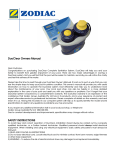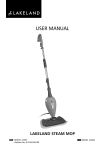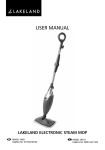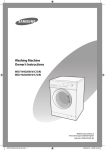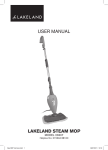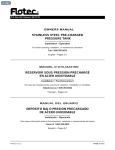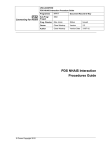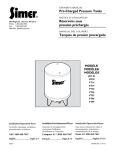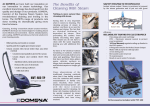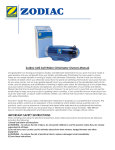Download Zodiac C-Series Chlorinator owners Manual
Transcript
Zodiac C-Series Chlorinator owners Manual Dear Customer, Congratulations on having purchased a Zodiac C Series Saltwater Chlorinator for your pool or spa. You have made a wise decision and you will benefit from your chlorinator for many years to come. There are two major benefits in owning a Zodiac Saltwater Chlorinator. The first is that you will save hundreds of dollars which you otherwise would have to spend on sanitizing chemicals for your pool or spa. Not only do you save money, but an even greater benefit which you will experience is the remarkable clarity of the water, and the pleasure and exhilaration of bathing in slightly salty water. By following just a few simple steps, your pool or spa will be a thing of beauty and pleasure, and will win the admiration of your family and friends. Please take the time to read through your Zodiac Owner’s Manual. It is set out in such a way that you can see the simple steps to keep your pool or spa in sparkling clean condition. If you would like to know more about how your new chlorinator works, or about water chemistry matters, you will find that this owner’s manual will provide you with useful information. And don’t forget that your chlorinator is backed by a comprehensive warranty. The exclusive Zodiac warranty is an expression of the confidence that Zodiac Group Australia Pty Ltd has in its products, and is your re-assurance of prompt and expert after-sales service by professional technicians. Thank you again for choosing a Zodiac Saltwater Chlorinator. We wish you many happy years of bathing in your "Zodiac" pool or spa. For more information talk to your local pool shop or telephone Zodiac Group Australia: 1800 688 552. Due to constant developments and improvements, specifications may change without notice HOW YOUR ZODIAC CHLORINATOR WORKS Common salt (sodium chloride) is made up of two elements, sodium and chlorine. When your Zodiac Saltwater Chlorinator is installed a measured quantity of salt is dissolved in the pool water to make it slightly salty. As part of the daily filtration cycle, the pool water is passed through a Zodiac electrolysis cell to produce chlorine which is dissolved instantly into the water. Your chlorinator also produces ozone in the cell, as a by-product. In simple, non-technical terms, the chlorine instantly starts to destroy bacteria, viruses, and algae and in doing this, reverts to dissolved salt. This cycle continues, with more new chlorine being produced from the salt water in the chlorinator cell, sanitising the pool, and changing once more back to dissolved salt. Everyday, when the chlorinator unit and the filtration system are switched on, dust and debris are trapped by the filter, and your chlorinator sanitises the water to make safe and sparkling clean Preferred Water Chemistry Readings OPERATING HINTS A) Filtration and Chlorination System Operating Periods Run your filtration and chlorination system for at least 6 to 8 hours per day. For best efficiency, operate the system in the cool hours of the evening, or the early morning. During very hot weather it might be necessary to run the system for around 10 hours per day, but in winter, it is only necessary to run the filtration system for around 4 hours per day. B) Chlorine Output Settings Make sure that you adjust the chlorine output of your Chlorinator to 80% or more. If you cannot achieve this output, the salt concentration is probably low, and more salt should be added to the pool. (See Problem J) For a typical home pool of about 60,000 litres, addition of one 25kg bag of salt will increase the Zodiac Saltwater Chlorinator meter reading by about 10%. C) Free (Residual) Chlorine Reading The free chlorine residual in the pool should be around 1 ppm - 3 ppm. Increasing the daily operating period of the system increases the free chlorine reading, and a shorter operating period reduces the chlorine reading. Likewise, operating the chlorinator with an output reading of 100% will produce a higher chlorine reading than operating the chlorinator at a lower setting of, say, 50%. D) Chlorine Stabiliser (Cyanuric Acid) level Make sure that the water has a satisfactory chlorine stabiliser (Cyanuric Acid) reading which is within the band of 40 to 80 ppm. Chlorine stabiliser helps to keep a satisfactory free chlorine reading in hot sunny climates. E) pH Readings. It is ABSOLUTELY ESSENTIAL that the pH of the pool be maintained in the range of 7.2 to 7.6 (for fibreglass pools, as low as 7.0). The effectiveness of chlorine as a sanitiser is significantly reduced as the pH rises. At a pH of 8.0, nearly all of the chlorine being added to the pool is wasted, and it will be almost impossible to maintain a satisfactory free chlorine reading. F) Regular Maintenance Checks Weekly: Check the cell electrodes. Clean the electrodes before the white calcium build-up becomes too thick. (See Chlorinator Maintenance Section) Check the free chlorine. Check the pH of the water. Adjust as necessary. Check the gauge on the filter to see if backwashing is necessary. Monthly: Check the salt concentration of the pool (see Salt: When & How to Add It) Check the Total Alkalinity. Adjust as necessary. Check the chlorine stabiliser reading. Adjust as necessary. SALT – WHEN AND HOW TO ADD IT When To Add Salt Turn the chlorine output control to maximum. If the chlorine output cannot reach at least 80% (preferably 100%), it is a strong indication that additional salt is required. (See Problem J) The salt concentration should normally be around 4,000 ppm, but should never be allowed to fall below 3,000 ppm, as this can reduce the life of the cell electrodes. For the 500 models, the salt concentration should normally be around 5,500 ppm, but as with other Zodiac models no less than 3,000 ppm. Salt is not lost through evaporation. Salt is lost with the water splashed out of the pool, or lost during backwash. Adding fresh water to the pool dilutes the salt concentration. A top up of salt is needed each year, and just before summer is the best time. How Much To Add Use only refined salt (sodium chloride) when adding salt to the water of your pool. For normal home pools of about 60,000 litres, one additional 25kg bag of salt will increase the chlorine output reading by about 10%. For larger pools, greater amounts of salt must be added. Add enough salt to obtain a chlorine output reading of at least 80%, although 100% is better. How To Add Salt Empty the contents of no more than two 25kg bags of salt at one time into the shallow end of the pool. The salt will slowly drift down to the deep end, helping to disperse the salt. Do not add the salt to the skimmer box. Run the filter for 4 to 6 hours to help disperse the salt around the pool. Note: Allow 24 hours for the salt to fully dissolve. Turn the chlorine output control to max and observe the meter, which will show a higher reading than before adding the salt. The reading should be at least 90%. If not, add more salt using the same procedure. If, after adding more salt the meter reading has only increased slightly, the cell could be approaching the end of its useful life. (See: “Problems That You May Encounter”, Problem J). SOME TIPS ON WATER CHEMISTRY pH IS VERY IMPORTANT Do not confuse pH with total alkalinity. pH is a simple numerical scale which expresses the acid/alkaline balance of water. A pH value of “7” denotes neutrality, i.e. neither acid nor alkaline. High pH values (i.e. above “7”) denotes alkaline conditions. Low pH values (below “7”) denote acidic conditions. How To Adjust pH Aim for a pH range of 7.2 to 7.6 which is ideal for maximum comfort and minimum chlorine demand. Always adjust the total alkalinity before adjusting pH. Low pH (acidic water) leads to stinging eyes and corrosion of open metal fittings. Raise pH by adding sodium bicarbonate soda ash, or dry alkali. First pre-dissolve in water, then add no more than 500 grams at a time. Check pH after each addition is thoroughly dispersed. High pH (alkaline water) leads to clouding of the water and prevents the sterilising action of chlorine. This means algae and germs can grow. Lower pH by adding hydrochloric acid to the pool water. The acid demand indicated by your 4-in-1 test kit will show the amount of acid to use. If you have the problem of never being able to keep the pH right, check your total alkalinity. TOTAL ALKALINITY AFFECTS pH Total alkalinity should be in the range 80-120 ppm. Total alkalinity is often confused with pH, which it affects. Total alkalinity is the measure of all the alkaline chemicals in your pool water (e.g. bicarbonates, carbonates, and hydroxides). It can be thought of as the buffering system necessary to control pH. Low total alkalinity can be compared to weak shock absorbers on a car, and the pH will go up and down like a perpetual yoyo. pH will be difficult to adjust and staining of pool surfaces may occur when total alkalinity is too low. To raise total alkalinity, add pH buffer (also called pH stabiliser or sodium bicarbonate) at the rate shown in the manufacturer’s instructions. A small amount is added daily to achieve a total alkalinity reading of 80-120 ppm. If total alkalinity is too high, scale will tend to form in the chlorinator cell, on pool walls, and in the heatexchanger of your heater. To lower total alkalinity, add 400 ml hydrochloric acid each day until a total alkalinity reading taken at least 24 hours later is in the range 80-120 ppm. When total alkalinity is finally correct you may need to adjust pH. Adjust total alkalinity to recommended range. Increase running time of filter and chlorinator. Make sure that the filter is clean and functioning properly. Use Chlorine Stabiliser (Cyanuric Acid ) to Protect Chlorine Residual This chemical acts as a sun-screen for chlorine and prevents chlorine being too quickly destroyed by the sun. Chlorine stabiliser is essential to prolong the life of chlorine in the pool water. It should be added following the manufacturer’s instructions. PROBLEMS THAT YOU MAY ENCOUNTER PROBLEM A Water looks clean but no chlorine RESIDUAL reading: To test for chlorine residual, switch on the filtration system and turn the Zodiac Saltwater Chlorinator to maximum output. (If the output is less than 80%, See Problem J) After a few minutes take a water sample from one of the points where filtered water returns to the pool. Test this water with your test kit. A minimum chlorine residual of 1 to 3 ppm is desirable. REMEDY: Adjust pH within the range 7.2 to 7.6 Make sure your cell is clean. Check cyanuric acid levels. Increase the setting of the chlorine output control. Increase meter readings to maximum output by adding salt. If problem continues, follow remedy for Problem B. Instructions to achieve a level of 40 to 80 ppm. This will probably be about 40 to 80 gm for every 1,000 litres of water. Take care that chlorine stabiliser levels do not exceed 80 ppm. PROBLEM B Pool green and no chlorine reading: Chlorine is still considered the most effective way of destroying algae and bacteria in your pool water. A chlorine residual of 1 to 3ppm is considered desirable. However, there are some types of harmful microorganisms and algae which develop immunity to these low levels of chlorine. REMEDY: Super chlorinating or shock dosing especially in hot weather, is the remedy. This procedure raises the chlorine residual to a very high level for a short period of time, and reduces chlorine demand. 1. Super chlorinating with a Zodiac chlorinator: i) Backwash the filter. ii) Adjust pH to 7.2 to 7.6. iii) Turn the Zodiac to maximum output and run the filter and the chlorinator for 24 hours continuously. Over-ride the time switch if one is fitted. iv) After 24 hours, backwash the filter. v) Re-adjust the pH to 7.2 to 7.6. vi) Check the chlorine reading before using the pool. Up to 5 ppm is not harmful. vii) If the chlorine reading is okay, set operating periods back to normal. viii) If chlorine reading is too low, repeat steps (iii) to (vi) until the chlorine reading is satisfactory. 2. Shock dosing with chlorine or oxidising agents: i) Backwash the filter. ii) Adjust pH to within the range 7.2 to 7.6. iii) Add 110 ml of liquid chlorine for every 1,000 litres of pool water - that is, 4.5 litres liquid chlorine for a pool of 40,000 litres OR add any suitable oxidising agent at the rate recommended by the manufacturer or your pool shop. When shock dosing, it is most important to add all in one dose. If in doubt, or if the problem is severe, use more rather than less, all in one dose. iv) After shock dosing, re-adjust pH to within range 7.2 to 7.6 and check chlorine level before using pool. Up to 5 ppm is not harmful. PROBLEM C Chlorine Odour: CAUSE: Not enough free chlorine. Surprisingly, the problem here is NOT too much chlorine as many imagine. Chloramines form by the bonding of chlorine with amines from sweat, urine, and other sources. These chloramines make the “chlorine” odour and can also cause eye and skin irritation. Free chlorine does not smell (up to 10 ppm concentration). REMEDY: Same as Problem B. PROBLEM D Slimy walls of pool or spa: CAUSE: Combined algae and bacteria growth. REMEDY: Scrub down affected walls and follow remedy as for Problem B, using a large shock dose of liquid chlorine. PROBLEM E Eye and/or skin irritation: CAUSE: Incorrect pH levels or chloramines. REMEDY: Adjust pH to 7.2 to 7.6 range (See “How to Adjust pH”) PROBLEM F Scale formation on pool equipment: To clean deposit (scale) from cell, see Chlorinator Maintenance Section. CAUSE (A): Incorrect pH and hard water. REMEDY: Adjust pH to range 7.2 to 7.6. CAUSE (B): High total alkalinity REMEDY: Adjust total alkalinity to 80-120 ppm. PROBLEM G POWER PACK red light “ON”: CAUSE: This is the flow indicator showing insufficient water flow through the cell. REMEDY (A): Ensure sufficient water flow through chlorinator cell. Is the filter pump on? Is flow restricted because the filter needs backwashing? Look for a pocket of air trapped in the top of the cell. This would confirm one of the problems just mentioned. e.g. Iow water flow through the cell. REMEDY (B): Make sure that the sensor lead from the power pack to the cell (the thin black lead) is firmly attached at the cell. PROBLEM H Chlorinator stops working, all lights “OFF”: CAUSE: Time switch in OFF mode. REMEDY: Adjust time switch. PROBLEM I POWER PACK Amber light “ON” chlorine output meter reads low: CAUSE (A): Chlorine control output set too low. REMEDY: Turn control up. CAUSE (B): Cell needs cleaning. REMEDY: Clean cell. CAUSE (C): If cell is clean, not enough salt in the pool water. REMEDY: Add salt according to instructions. CAUSE (D): Damaged electrodes. REMEDY: Replace electrode. CAUSE (E): Low water temperature in winter. REMEDY: Check again during summer. PROBLEM J READING ON CHLORINE OUTPUT METER CANNOT BE SET TO 100% CAUSE (A): Salt concentration too low. It should be 4,000 ppm to allow output to reach 100%. REMEDY: *Add two large handfuls of salt to the skimmer box while the system is running. Make sure that the output control is turned to maximum, and observe the chlorine output meter. If low salt concentration is the cause of the low meter reading, the meter pointer will start to rise after about 20 seconds, and should rise up to the maximum reading on the meter and then slowly fall back to its original reading. This test proves that the low reading is due to low salt concentration. Add one or more 25 kg bags of salt into the shallow end of the pool to obtain the maximum reading when the salt is fully dissolved. *NOTE: DO NOT add salt directly through the skimmer box except for this test. CAUSE (B): Chlorinator cell is failing. If the previously described test of adding handfuls of salt to the skimmer box makes little difference to the meter reading, the cell may be close to failure. REMEDY: Contact your Zodiac Service Technician or your pool shop to have the cell tested. CAUSE (C): Cell is covered in white coating (calcium deposit). REMEDY: See “Check and Clean your cell” page 12. CAUSE (D): Cold water during winter. REMEDY: Check again when water warms up. CHECK AND CLEAN YOUR CELL - OR IT WILL DIE!!! Initially, check your cell every week for deposit (or scale) on the electrodes. This will enable you to determine the cleaning period. All salt chlorinator cells must be cleaned before scale builds up to the point where the electrode gaps in the cell are bridged. If the cell operates with deposit bridging the electrode gaps it can be irreparably damaged and the electrodes may have to be replaced. CHLORINATOR MAINTENANCE How To Clean Your Cell i) Switch off the filter pump and chlorinator and disconnect from the power outlet, close necessary valves. ii) Unplug the leads from the cell terminals. iii) Unscrew the large ribbed plastic nut, and carefully withdraw the electrodes. iv) Direct a fast water jet from the garden hose onto electrode to clean. If ineffective, immerse electrode bundle in cleaning mixture. You can purchase cell cleaning solution from a pool shop, or mix your own in a suitable plastic vessel, adding one part of Hydrochloric (muriatic) Acid to 10 parts of water. Immerse the electrodes (but not the terminals) in the cleaning solution for a few minutes until clean. Make up a second batch of the mixture if necessary. Rinse electrodes in clean water and re-install. v) Replace electrical connections. vi) Reset valves and switches. Turn pump and chlorinator on. vii) Check meter reading on power pack. viii) Use only silicon grease with cell plastics. Do NOT lubricate terminals. METER READINGS - WHAT THEY MEAN The meter reading shows that chlorine is being produced. It does not measure the amount of chlorine in the water. If your meter is reading well below maximum, your cell may need cleaning or more salt may be needed. See “Salt, how to add it, and how much to add”. See also Problem J in “Problems that you may encounter.” DAMAGE CAUSED BY INSECTS The case of the Zodiac Saltwater Chlorinator power pack has small air vents to allow internal components to remain cool in hot weather. Sometimes small insects may enter the case of the power pack, and this can cause damage to the internal electrical components. To help avoid this, spray some insect repellent on the outside surfaces around the power pack. DO NOT spray directly inside the power pack. TIME SWITCH - where fitted Set Clock to Present Time of Day Turn the knob in the centre of the clock in a clockwise direction only (as shown by the arrow) until the correct time is shown. Make sure that the time setting of the clock face and the 24-hour dial corresponds with the time of day. For example, at, 6.00 pm, the clock face should show 6 o’clock and the 24-hour dial should correspond to 1800 hours. To Set Switching Time and Operating Period Click inwards any number of the setting tabs (which are spaced around the 24 hour dial), so that the red marker shows. The chlorinator will switch on for the duration of the time period indicated by the red markers. DO NOT turn the knob anti clockwise. DO NOT turn the outer dial to set the clock. To Over-ride the Time Switch The chlorinator may be switched ON during an OFF cycle by moving the over-ride switch from “auto” to “on”. This switch is recessed to prevent accidental switching. Be sure to return the switch to the “auto” position later on. Use thumb nail to operate this switch. NEVER plug more than one pump at a time into the 3pin plug in the power pack. DO NOT turn the switch knob anti-clockwise. DO NOT turn the outer dial to set the clock. Specifications:- Motor load - up to 1.5 h.p. Maximum switching capacity - 15 amps. 50 Hz/60Hz setting Note that the 50Hz/60Hz switch should normally be in the 50Hz position. In the USA and other 60Hz countries, set the switch to 60Hz. Incorrect setting will cause the timeswitch to lose or gain time. INDICATOR LIGHTS ON CONTROL CENTRE To protect your pool and its equipment, there is an electronic flow switch in your chlorinator power pack which automatically switches the chlorinator “OFF” when water flow ceases. In addition there is an electronic circuit which automatically tests the electrodes for calcium build-up and the water concentration. RED LIGHT ON indicates that the water flow is low, or has stopped and the chlorinator is OFF. When water flow resumes, the chlorinator automatically switches on and the red light goes off. AMBER LIGHT ON indicates that either the cell electrodes require cleaning, or the salt concentration in the pool water has dropped. GREEN LIGHT ON indicates that the power pack is providing electrical power to the cell to produce chlorine. CAUTION Failure to observe the following could invalidate your warranty and damage your pool equipment. 1. Chlorinator should be installed by an experienced Pool Technician. Failure to install and operate this product as specified may result in a hazardous situation which could cause personal injury or property damage. 2. Your salt chlorinator has been fitted with an electronic flow switch. This device automatically switches the chlorinator “OFF” when the water flow through the cell stops. Do not in any way interfere with this system which has been fitted for your protection. 3. Do not dismantle the electrode bundle or detach it from the end-cap. 4. Red and black terminals attached to the end-cap must be kept dry. Do not immerse these terminals in acid-wash solution. 5. Water above the temperature of 40 degrees Celsius (104 degrees F.) must not flow through the cell. 6. Water pressure in the cell must not exceed 276kPa (40 psi). 7. Deposit or scale must not be allowed to build up so thick as to bridge the gap between the electrodes of your cell. Clean the cell regularly. 8. Power pack must not be installed directly above any other heat source such as filter pump or heater. It must be at least 1.3 metres from the ground, to allow free circulation of air around it, and at least 3.0 metres from the edge of the pool. It must not be in a closed box. 9. Never plug more than one pump at a time into the 3-pin socket in the base of the power pack. 10. Use only silicon grease on the cell housing. Do not use petroleum based lubricants. Do not lubricate terminals. Warranty Your Zodiac Chlorinator has been manufactured with the greatest of care and from the best available materials. The warranty period begins on the date of the manufacture according to the serial number on the product, unless proof of purchase date is supplied, or the warranty has been registered with us. Refer also to the section titled "Caution" in the Owner’s Manual. This warranty will be void if parts other than Zodiac approved parts are used for repairs. Chlorinator (excluding cell electrodes) Warranty The manufacturer warrants for a period of 2 years from the date of purchase, defects found to be due solely to faulty materials or workmanship. It will repair or replace at its option such faulty materials or parts free of charge. Cell Electrode Warranty The cell electrodes and their special coatings are covered by a 2-year full warranty. In addition to the 2-year full warranty, the manufacturer warrants the products for a subsequent 3-year period, pro-rated over the five years. The cost of field service calls, or of freight back for repairs are not covered by the warranty. The Zodiac warranty is transferable and protects the original purchaser and subsequent owners of the product. Proof of purchase or registration of the warranty with Zodiac Group Australia Pty Ltd must be provided by the owner to support any warranty claim. This pro-rata warranty is offered by Zodiac directly to the chlorinator end-user and requires that person to deal directly with Zodiac Group Australia Pty Ltd. *The warranty applicable to commercial application is limited to 12 months from the date of installation. For more information talk to your local pool shop or telephone Zodiac Group Australia: 1800 688 552 or access our webpage: www.zodiac.com.au. Due to constant developments and improvements, specifications may change without notice.











